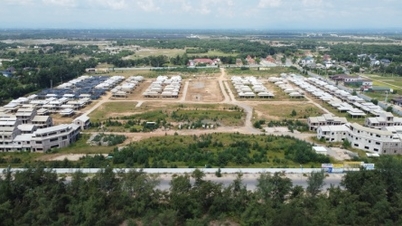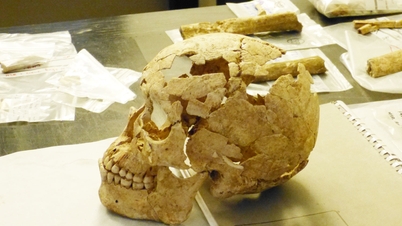Rare autoimmune disease that damages multiple organs
The patient is Mr. D., with a history of bronchial asthma and has smoked for more than 20 years. In the past 4 months, he has continuously lost 7kg, is often tired, has a poor appetite, has numbness in both arms and legs, and has a dry cough in the evening.
 |
| People should go to a medical facility if they experience prolonged unusual symptoms such as fever, weight loss, numbness, difficulty breathing, chest pain, muscle pain or unexplained fatigue. |
Suspecting he had cancer, he went for a screening but the results showed no abnormalities. When his condition worsened, he went to Tam Anh General Hospital in Hanoi for a check-up.
Here, MSc. Nguyen Thi Anh Ngoc (Department of Musculoskeletal) said that through clinical examination and paraclinical testing, doctors recorded many abnormal signs.
Specifically, Mr. D. had a high fever of over 38 degrees Celsius, severe numbness in his limbs, blood eosinophil count 10 times higher than normal (2.65 G/L), and a positive vasculitis antibody test. Chest CT scan results showed inflammatory ground-glass lesions in the upper lobe of the right lung.
Not only the lungs are damaged, the patient is also affected in many other organs such as the heart muscle (causing heart failure), peripheral nerves, and muscles.
Muscle biopsy results revealed infiltration of eosinophils, a type of immune cell often associated with allergic reactions or autoimmune disorders.
From these signs, the doctor diagnosed Mr. Duy with eosinophilic granulomatosis with polyangiitis (EGPA), a rare autoimmune disease with an incidence of about 0.5-4 people per million people.
Immediately after accurately diagnosing the disease, the doctors conducted an interdisciplinary consultation and developed a comprehensive treatment plan. Mr. D. was treated with high doses of anti-inflammatory drugs and immunosuppressants to control the vasculitis and its complications.
After 9 days of intensive treatment, clinical symptoms improved significantly: the patient no longer had a fever, no more numbness in the limbs, ate well, walked normally, and test results gradually stabilized. The patient is now entering the maintenance treatment phase and will be closely monitored after discharge.
Doctor Nguyen Thi Anh Ngoc said that EGPA is a very rare autoimmune disease that occurs when the body's immune system "mistakenly recognizes" blood vessels as harmful agents and attacks them. The disease causes inflammation of small and medium blood vessels, leading to damage in many organs such as the lungs, heart, skin, nerves, kidneys...
The cause of the disease is not clearly identified, but is often related to immune disorders, especially in people with allergies such as bronchial asthma, chronic sinusitis and prolonged eosinophilia.
Other risk factors such as infection, genetics, environmental pollution, exposure to toxic chemicals, especially smoking, can also contribute to activating an abnormal immune response, making the disease more severe.
Treatment of EGPA is a complex process, requiring coordination between many specialties such as musculoskeletal, immunology, cardiovascular and neurology to develop a suitable regimen for each patient. Treatment does not stop at controlling symptoms, it needs to be individualized, long-term monitoring to limit complications and improve quality of life.
Doctor Ngoc warned that if not treated promptly, the disease can cause many dangerous complications such as heart damage, kidney failure, blood clots, stroke, or even be life-threatening.
Symptoms of the disease are easily confused with other diseases such as cancer or chronic inflammation, so early detection plays an extremely important role.
People should go to a medical facility if they experience prolonged unusual symptoms such as fever, weight loss, numbness, difficulty breathing, chest pain, muscle pain or unexplained fatigue.
Medical facilities with a multidisciplinary examination and treatment model will be the right choice to ensure that patients are accurately diagnosed and treated comprehensively. This not only helps to control the disease well but also prevents dangerous complications that may occur in the future.
Health consequences of long-term exposure to pesticides
After 7 years of marriage without having children, Mr. H. (34 years old, Tien Giang ) discovered that he was infertile, suspected to be due to 20 years of exposure to pesticides without safe protective measures.
His case is a warning bell for many agricultural workers about the serious effects of toxic chemicals on reproductive health.
Mr. H. said that he has been growing fruit trees since he was a child. For nearly 20 years, he has regularly sprayed pesticides and herbicides without wearing a mask or protective clothing.
After getting married, the couple wanted a child but had no good news. In 2023, they went to Ho Chi Minh City for in vitro fertilization (IVF), but failed because they could not get sperm.
In March 2025, with renewed hope, Mr. H. and his wife came to the Center for Reproductive Support, IVF Tam Anh, Ho Chi Minh City. Here, Dr. Nguyen Cong Danh, Department of Andrology, IVF Tam Anh Center received and examined the patient. The results showed that his testicles had shrunk, only about 6 ml (half of normal). Semen analysis showed that there were very few sperm and up to 96% of them were immobile.
Although genetic testing did not detect any abnormalities, Mr. H. showed signs of serious hormonal imbalance, hypothalamic-pituitary-gonadal axis disorders, causing impaired spermatogenesis.
In addition, he also had feminization symptoms such as soft voice and breast development, indicating that the injury had occurred over a long period of time.
According to Dr. Danh, chemicals in pesticides such as insecticides and herbicides can cause endocrine disorders, reduce testosterone levels, increase female hormones (estrogen), thereby causing testicular atrophy, reducing sperm density, increasing the rate of immobile sperm, and even breaking down the structure of sperm DNA.
If exposed for a long time, the risk of male infertility increases and can affect the health of the fetus if conception is successful.
Immediately after a comprehensive assessment, Dr. Danh developed an endocrine treatment regimen for Mr. H. to improve sperm quality. Before starting treatment, the doctor froze a sperm sample as a backup in case the treatment was ineffective.
He was also advised to use full protective gear when farming, including waterproof clothing, masks, goggles and boots. In addition, he should limit alcohol and tobacco, avoid staying up late, and eat nutritious food to support hormones.
After a month of taking the medicine, Mr. H.'s semen analysis improved significantly. On the day his wife had her eggs retrieved, he was able to take a fresh sperm sample to perform the intracytoplasmic sperm injection (ICSI) technique.
In the laboratory, the embryologist selected 10 healthy sperms to create embryos. The embryo culture process in the modern Time-lapse system resulted in 7 good quality 5-day embryos.
After preparing the wife's uterine lining, the doctor transferred a high-quality embryo into the uterus. The pregnancy is now 8 weeks old and developing steadily.
Doctor Danh warns that long-term exposure to toxic chemicals without protection not only affects fertility but also increases the risk of skin, respiratory, nervous system diseases and even cancer. In addition to the direct impact on users, chemical residues also pollute the living environment and affect public health.
Men who work in toxic environments, high temperatures such as drivers, mechanics, exposed to radiation, heavy metals, living in polluted areas, or suffering from male genital infections, psychological disorders, etc. are also at risk of reproductive dysfunction. Therefore, regular health check-ups, especially reproductive health, are necessary.
In the case of unmarried men at risk of infertility, doctors recommend freezing sperm to preserve future fertility.
At Tam Anh IVF Center, modern vitrification technology for freezing sperm, eggs and embryos helps preserve reproductive materials in a liquid nitrogen environment of -196 degrees Celsius, maintaining their biological state and ability to develop after thawing.
For couples who have been married for over a year but have not had children, doctors advise early examination to determine the cause and timely treatment to increase the chance of having children and save time and money.
Osteoporosis at age 27 due to vitamin D deficiency
With no underlying medical conditions or obvious symptoms, Minh Anh (27 years old, office worker) was suddenly diagnosed with osteoporosis during a routine health check-up. The cause was determined to be vitamin D deficiency, a condition that is increasingly common in young people.
According to MSc. Dr. Nguyen Thi Anh Ngoc, a specialist in Musculoskeletal, the bone density measurement results using the DEXA method showed that Minh Anh's Z-score was -2.9, much lower than the normal threshold (Z-score ≥ -1.0) according to the standards of the World Health Organization (WHO).
Blood tests showed a 25-OH vitamin D level of only 25 nmol/L, while the level needed to maintain bone health is above 50 nmol/L. The doctor diagnosed the patient with secondary osteoporosis due to vitamin D deficiency.
Minh Anh has normal overall health, liver, kidney and endocrine functions show no signs of abnormalities. However, the patient has a sedentary lifestyle, works in an office all day indoors, and has very little exposure to sunlight.
When going out, Minh Anh always uses sunscreen, wears thick coats, and covers her whole body. "These are typical factors that lead to vitamin D deficiency, which seriously affects bone health," said Dr. Ngoc.
To restore her musculoskeletal system, Minh Anh was prescribed a therapeutic dose of vitamin D, combined with calcium, dietary changes, and increased outdoor activity. It is expected that after 3 months, the doctor will re-examine her vitamin D levels and bone density to evaluate the effectiveness of the treatment.
Osteoporosis is considered a common disease in the elderly, but doctors are now seeing more and more patients in their 20s and 30s suffering from secondary osteoporosis. At Tam Anh General Hospital, many young cases are discovered during routine health check-ups or after a bone fracture due to a minor impact.
According to Dr. Ngoc, the main causes are a modern lifestyle of lack of exercise, little exposure to sunlight, poor nutrition, smoking, consuming processed foods or drug abuse. Some people also use long-term medications such as corticosteroids, anti-epileptic drugs, anticoagulants, all of which can silently reduce bone density.
Osteoporosis in young people can also originate from endocrine disorders (oestrogen deficiency), hyperthyroidism, enteritis, malabsorption syndrome, autoimmune arthritis, liver failure or kidney failure.
Vitamin D plays an important role in the absorption of calcium in the intestines and kidneys, thereby maintaining calcium levels in the blood and helping to strengthen bones. The body mainly synthesizes vitamin D through the skin when exposed to ultraviolet rays from sunlight.
However, many young people today spend most of their time indoors, avoid the sun too much and use sunscreen continuously, making it impossible for their skin to absorb light to synthesize natural vitamin D.
Vitamin D deficiency not only causes osteoporosis but also affects the immune system, increases the risk of depression, sleep disorders, cardiovascular and metabolic diseases.
If not detected early, osteoporosis can lead to bone fractures, spinal deformities, reduced height, chronic pain, and seriously affect daily life and work ability, especially if the fracture occurs at locations such as the femoral neck, wrist, or spine.
Doctor Ngoc noted that bone mass peaks at the age of 25-30. If bone density is low during this period, the patient will not have enough “bone reserves” for old age, increasing the risk of early and more severe osteoporosis when aging.
The problem is that osteoporosis in young people often has no obvious symptoms, causes little pain, does not limit movement, and is easily overlooked until discovered by chance through bone density measurement or after a minor injury.
Diagnosis of osteoporosis cannot be based on subjective feelings, but requires in-depth tests such as measuring bone density by DEXA method, the current gold standard. In addition, blood tests to quantify vitamin D, calcium, phosphorus, PTH are also performed to determine the cause and level of deficiency.
For people who have no signs of the disease, regular screening for osteoporosis is necessary, especially if they are in the risk group such as people who rarely get sun exposure, women with menstrual disorders, vegetarians, long-term corticosteroid users, have a history of bone fractures or a family history of early osteoporosis.
Doctors recommend maintaining a healthy lifestyle: eating enough nutrients, especially calcium and vitamin D; exercising regularly, prioritizing outdoor activities for at least 30 minutes a day; avoiding smoking, limiting alcohol, processed foods and stimulants.
The ideal time for sunbathing is from 6:30 to 9:00 am or after 3:00 pm, when the UV intensity is safe, helping the body synthesize vitamin D effectively without damaging the skin. If micronutrient supplements are needed, patients should use them as prescribed by a doctor, avoiding buying functional foods on their own that can cause metabolic disorders or vitamin D poisoning.
Source: https://baodautu.vn/tin-moi-y-te-ngay-267-canh-bao-benh-tu-mien-hiem-gap-gay-ton-thuong-nhieu-co-quan-d341109.html


![[Photo] Party Committees of Central Party agencies summarize the implementation of Resolution No. 18-NQ/TW and the direction of the Party Congress](https://vphoto.vietnam.vn/thumb/1200x675/vietnam/resource/IMAGE/2025/10/27/1761545645968_ndo_br_1-jpg.webp)
![[Photo] The 5th Patriotic Emulation Congress of the Central Inspection Commission](https://vphoto.vietnam.vn/thumb/1200x675/vietnam/resource/IMAGE/2025/10/27/1761566862838_ndo_br_1-1858-jpg.webp)

![[Photo] National Assembly Chairman Tran Thanh Man receives Chairman of the House of Representatives of Uzbekistan Nuriddin Ismoilov](https://vphoto.vietnam.vn/thumb/1200x675/vietnam/resource/IMAGE/2025/10/27/1761542647910_bnd-2610-jpg.webp)










































































































Comment (0)